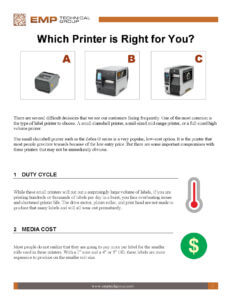There are several difficult decisions that we see our customers facing frequently. One of the most common is the type of label printer to choose. A small clamshell printer, a mid-sized mid-range printer, or a full-sized high volume printer.
A small clamshell printer such as the Zebra G-series is a very popular, low-cost option. It is the printer that most people gravitate towards because of the low entry price. But there are some important compromises with these printers that may not be immediately obvious.
Duty Cycle
While these small printers will put out a surprisingly large volume of labels, if you are printing hundreds or thousands of labels per day in a burst, you face overheating issues and shortened printer life. The drive motor, platen roller, and print head are not made to produce that many labels and will all wear out prematurely.
Media Cost
Most people do not realize that they are going to pay more per label for the smaller rolls used in these printers. With a 1” core and a 4” or 5” OD, these labels are more expensive to produce on the smaller roll size.
Change Over Frequency
Because the media is smaller, there are fewer labels per roll and the changeover is more frequent. If you are only printing a hundred labels or so per day, that might be OK, but if you are printing higher volumes and have a larger label, that could mean you are changing over label rolls several times per day.
Label Cupping
Since the core size is 1” versus 3” for the larger printers, the last 1/4th of the roll has the labels wound on a much smaller arc. Meaning that the label is more likely to jam when printed, going to be harder to handle and place on the product, and more likely to peel and fall off of the product once applied.
Thermal Transfer
The initial printer cost and ongoing media price increase only go up if you plan to use the clamshell as a thermal transfer printer. You have to ask yourself if direct thermal labels will work for your application. If subjected to heat, a direct thermal label can fade away within 6 months. If subjected to sunlight and heat, a direct thermal label can fade to blank within a week. You would not be the first frantic call that we have received when it is realized that all of the labels on older products in your warehouse can no longer be read. If your label needs to last more than a month indoors, have resistance to UV, abrasion, or chemicals, then a thermal transfer printer is a must.
Media Options
Something not obvious is the limited media selection that you have with a clamshell printer. Fewer stock label sizes, very minimum stock synthetic labels, and almost nonexistent resin ribbons. The resin ribbons are almost nonexistent because the amount of heat that it takes to transfer those images will overheat a clamshell printer in no time. Plus, the ribbon costs are much higher for resin ribbons than printers that use full-sized ribbons.
Printer Options
The smaller clamshell printers do not have a liner take-up option, a label rewind option, or a cutter option. If you require any of these, then a clamshell printer is not a consideration.
Printer Size
If you absolutely do not have space for a full-sized printer, then the clamshell printer is a strong consideration, if you can live with all of the above.
Printer Cost
Not so fast! The initial cost of a clamshell-style printer may be lower, but the Total Cost of Ownership is probably not when you consider all of the above.
As always, we are here to help you navigate these types of decisions and select a product that will give you years of worry-free service.
Contact us today to engage one of our product experts!
